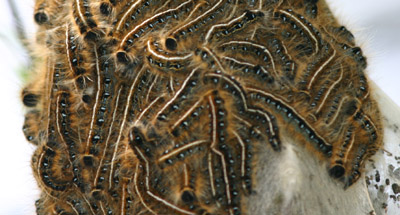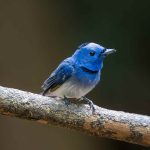Most residents of New York state, particularly those who can muster a glance at the treetops now and again, are familiar with the writhing, webby nests of the Eastern Tent Caterpillar (Malacosoma americanum), though few have a solid idea what they’re observing. I’m embarrassed to say that until recently, as in just a couple of days ago, I was counted among the masses of those who mistake these pests for Gypsy Moth Caterpillars. Still, you may not know this caterpillar’s name, but you can probably recognize its work. Tent Caterpillars, both Eastern and Forest, are voracious leaf eaters that strip huge swathes of trees bare in their quest for moth-hood.

I observed the faintly undulating larval conglomerate above and plenty more like it just last month. What appeared to be an apparent increase in the number of local nests actually signified a population boom at the peak of a multi-year cycle. Tent caterpillars abound throughout the Northeast right now. According to my father-in-law, they’re eating their way across the Southern Tier as we speak, leaving bare branches in their wake.
Though the defoliation tent caterpillars visit on trees, particularly black cherry and other Prunus species, looks fatal, it rarely inflicts lasting damage to otherwise healthy specimens. Believe it or not, a tree can survive the meticulous consumption of each and every leaf, as long as this assault isn’t sustained for years on end. Who knew?
When confronted by a massive cluster of plump bugs, it’s natural for naturalist types to ask, “What eats them?” After all, everything feeds something in this web of life. Tent caterpillars do their part by feeding a variety of insects, rodents, and reptiles. They also sustain certain birds, especially cuckoos and orioles, which, not coincidentally, also seem to be doing fairly well in New York this year too. Sapsuckers are among the birds that feed on the nondescript, brown eastern tent caterpillar moths.













Leave a Comment